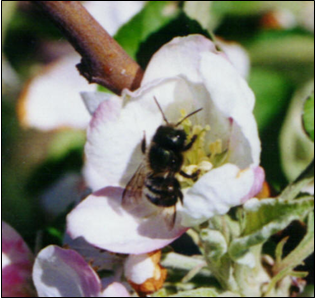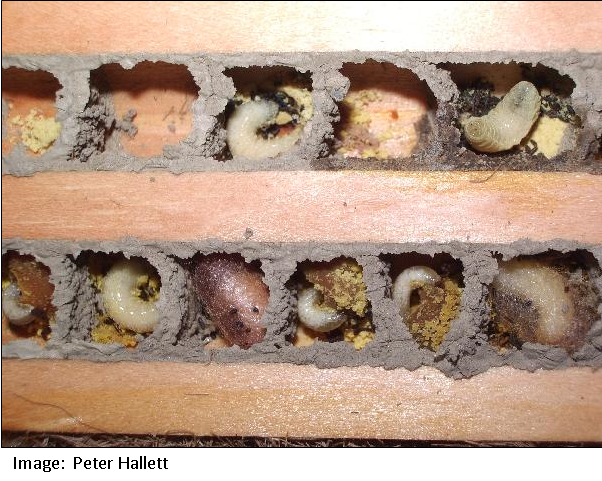Blue Orchard Bees in Agriculture
 The blue orchard bee, Osmia lignaria, is used to pollinate orchard fruits (cherries, apple, apricot, almond, plums/prunes,
peaches, nectarines, and pears) either alone or as a supplement along with hives of
honey bees. The blue orchard bee is a common and widely distributed native bees,
and will often turn up opportunistically wherever their preferred pollen sources are
available. They can be managed intentionally by providing appropriate nesting materials,
and populations can be augmented by purchasing additional bees. Typically, several
hundred blue orchard bees are required to pollinate one acre of apples or cherries.
The blue orchard bee, Osmia lignaria, is used to pollinate orchard fruits (cherries, apple, apricot, almond, plums/prunes,
peaches, nectarines, and pears) either alone or as a supplement along with hives of
honey bees. The blue orchard bee is a common and widely distributed native bees,
and will often turn up opportunistically wherever their preferred pollen sources are
available. They can be managed intentionally by providing appropriate nesting materials,
and populations can be augmented by purchasing additional bees. Typically, several
hundred blue orchard bees are required to pollinate one acre of apples or cherries.
 Other Osmia species are also useful to commercial fruit production. For example, Osmia aglaia is a good pollinator for raspberries and other cane fruits in the Pacific Northwest
region of the U.S. See:http://www.ars.usda.gov/Research/docs.htm?docid=18366
Other Osmia species are also useful to commercial fruit production. For example, Osmia aglaia is a good pollinator for raspberries and other cane fruits in the Pacific Northwest
region of the U.S. See:http://www.ars.usda.gov/Research/docs.htm?docid=18366
Blue orchard bees are solitary bees, meaning that they do not live in colonies like
honey bees and bumble bees do. Female solitary bees build and provision their nests
independently. However, like other species of solitary bee, the blue orchard bee
likes to nest in aggregations containing the nests of many other females. This trait
makes management convenient because large nest-hole arrays can be provided for them
in an efficient manner. Blue orchard bee nests consist of a linear series of cells
containing pollen and nectar masses (“bee bread”) for the larvae; individual cells
are separated by plugs of dried mud collected by the female. Under unmanaged conditions
the nests are built in natural cavities in wood, such as beetle tunnels, or in human-made
cavities such as gaps in the siding on buildings. One egg is laid on each cell.
Providing blocks of lumber or natural logs drilled with holes will attract many nesting females of the blue orchard bee, and will attract other beneficial solitary bee species as well. For blue orchard bees, a ¼” drill bit works well, drilling to a depth of 4 to 7 inches. Neighboring holes can be quite close, but separating holes by about ½” makes it easier to drill the holes without crossing tunnels, especially with longer drill bits which tend to bend during drilling. At least two nest holes should be provided per female. Bees will also nest in bundles of natural plant straws, but using straws can make the brood cells more vulnerable to attack by tiny female parasitoid wasps, who insert their eggs into host nests and whose own young devour the developing larvae of the blue orchard bee.
More information on blue orchard bees.
http://www.ars.usda.gov/Research/docs.htm?docid=18333
http://extension.usu.edu/files/publications/factsheet/blue-orchard-bee.pdf
